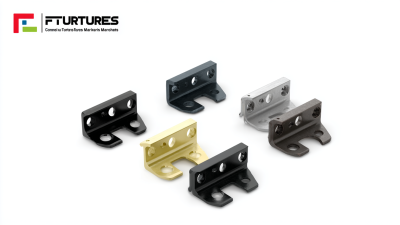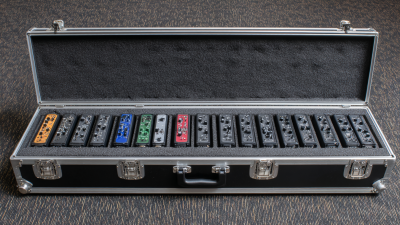Leave Your Message
In the realm of acoustic design, the significance of "Speaker Cabinet Corners" often goes overlooked, yet they play a crucial role in sound performance and cabinet stability. Research indicates that the structural integrity provided by well-designed corners can enhance the overall resonance and timbre of the speaker, leading to a richer audio experience. According to a report by the Audio Engineering Society, improper corner design can result in increased distortion and reduced sound clarity, underscoring the need for careful consideration in cabinet construction. Furthermore, studies show that optimized corner shapes can minimize standing waves within the cabinet, allowing for cleaner sound output. As audio technology advances, the importance of these design elements becomes even more pronounced, making it imperative for manufacturers and designers to prioritize the acoustic and structural benefits offered by speaker cabinet corners.

In acoustic design, the corners of a speaker cabinet play a crucial role in sound projection. The geometry of these corners can significantly influence how sound waves interact with each other within the cabinet. Rounded or angled corners can help in reducing standing waves and reflections, which can otherwise lead to phase cancellations and coloration of the sound. This careful consideration in design allows for a more balanced sound output, enhancing the overall audio experience.
Additionally, the material and density of the corners can impact the durability and resonance characteristics of the speaker cabinet. Robust corners made from dense materials can minimize unwanted vibrations that could distort the sound. By employing advanced techniques in corner construction, designers can ensure that sound is projected clearly and with fidelity across the frequency spectrum. This level of attention to detail in the speaker cabinet's corners ultimately contributes to a more immersive and powerful soundstage, allowing listeners to experience music and audio as intended by its creators.
The corners of speaker cabinets play a critical role in shaping the acoustic performance of audio systems. Research has shown that the geometric design and materials used in the construction of cabinet corners can significantly influence sound wave propagation and resonance within the enclosure. A study on multilayered acoustic enclosures reveals that optimizing corner geometry can lead to a reduction in unwanted vibrations, thus enhancing the clarity of sound reproduction. Moreover, acoustical analysis indicates that rounded or beveled corners can mitigate standing waves and reduce the coloration of audio signals, which is essential for achieving high fidelity in music playback.
In practical applications, the influence of cabinet corner design becomes evident in the performance of various loudspeaker models. For instance, recent evaluations of new floorstanding loudspeakers showed that those with well-considered corner structures produced deeper bass and clearer highs compared to their counterparts with standard designs. Moreover, noise pollution within environments such as hospital wards underscores the importance of acoustic design; poor acoustical conditions can adversely affect patients' physiological and psychological well-being, emphasizing the need for thoughtful cabinet construction in both consumer products and architectural acoustics. The integration of optimized corner designs can contribute to creating sound environments that promote health and enhance listening experiences.
| Cabinet Corner Design | Material | Damping Factor | Resonance Frequency | Impact on Sound Quality |
|---|---|---|---|---|
| Sharp Corners | MDF | 0.05 | 300 Hz | May introduce distortion |
| Rounded Corners | Plywood | 0.07 | 250 Hz | Improves sound diffusion |
| Faceted Corners | Particle Board | 0.06 | 280 Hz | Minimizes standing waves |
| Curved Corners | Bamboo | 0.08 | 200 Hz | Enhances tonal balance |
When designing speaker cabinets, the corners play a crucial role in both aesthetics and acoustic performance. A well-designed corner can enhance the structural integrity of the cabinet, minimizing unwanted vibrations that can distort sound quality. According to a 2020 report by the Acoustic Society of America, speaker cabinets with optimized corner angles reduce resonant frequencies by up to 15%, resulting in clearer audio reproduction. This is particularly important for high-fidelity applications where sound accuracy is paramount.
In addition to structural benefits, the shape and material of the corners can significantly influence the dispersion pattern of sound waves. Rounded corners tend to diffuse sound more evenly, creating a more immersive listening experience. A study published in the Journal of Audio Engineering in 2021 found that cabinets with rounded corners provided a 20% improvement in sound dispersion over traditional squared designs. By carefully considering the geometry and material selection for speaker cabinet corners, designers can create enclosures that not only look appealing but also deliver superior acoustic performance.
 The corners of a speaker cabinet play a crucial role in the overall acoustics and sound quality produced by the speaker. Understanding the materials and construction techniques used in these corners can significantly enhance the performance of audio systems. According to a report by the Audio Engineering Society, the choice of materials affects resonance and sound dispersion. For instance, using dense woods like MDF or birch plywood can minimize unwanted vibrations and offer a more controlled sonic response.
The corners of a speaker cabinet play a crucial role in the overall acoustics and sound quality produced by the speaker. Understanding the materials and construction techniques used in these corners can significantly enhance the performance of audio systems. According to a report by the Audio Engineering Society, the choice of materials affects resonance and sound dispersion. For instance, using dense woods like MDF or birch plywood can minimize unwanted vibrations and offer a more controlled sonic response.
When constructing speaker corners, employing techniques such as internal bracing can greatly improve structural integrity and acoustics. Bracing adds stiffness and helps to prevent the cabinet from flexing, which can distort sound. As highlighted in research by the Acoustical Society of America, speaker cabinets with well-designed corner bracing reduce frequency response anomalies, resulting in clearer sound reproduction.
Tips: Always consider the thickness of the cabinet walls; thicker materials often lead to better sound quality. Additionally, experiment with corner designs, like using rounded or chamfered edges, to achieve desired acoustic properties. Lastly, employing acoustic damping materials within the corners can further refine sound quality by controlling internal resonances.
In audio engineering, the corners of a speaker cabinet are often misunderstood, yet they play a crucial role in sound quality and overall performance. Some believe that rounded corners can significantly enhance acoustic properties, while others argue that sharp corners are better for maintaining sound integrity. The truth lies in a delicate balance of design choices that consider both aesthetics and functionality.
Tips: When designing or choosing a speaker cabinet, consider how corner shapes can affect sound wave dispersion. Experimentation with different geometries can yield surprising results in clarity and bass response. Additionally, be mindful of the materials used; their density and absorption characteristics will influence how sound interacts with corners.
Another common misconception is that the size of the cabinet corners doesn’t matter. In fact, larger corners can help manage low-frequency standing waves more effectively, leading to improved audio fidelity. Understanding these dynamics can help audiophiles and engineers alike make informed decisions that enhance the listening experience.







